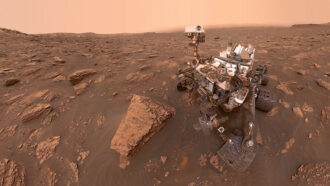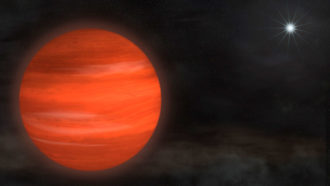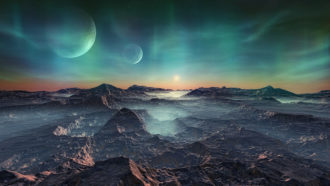Planets
-
 Space
SpaceThere’s water on sunny parts of the moon, scientists confirm
The new observations were made by a telescope on board a jet in Earth’s atmosphere. They confirm the presence of water on sunlit areas of the moon.
-
 Planets
PlanetsLet’s learn about Mars
Traveling to Mars offers many challenges, including life without gravity, cosmic rays and communication delays.
-
 Space
SpaceScientists Say: Gravity
Gravity is a fundamental force that attracts objects with mass to other objects with mass. It decreases with distance.
-
 Tech
TechLet’s learn about space robots
Space robots can take pictures of other planets, analyze samples of their surface and even peer into their interiors.
-
 Planets
PlanetsSaturn’s moon Titan may host lots of dried lakes
Suspicious spots around the moon’s middle could be the beds of ancient lakes. If so, this might solve a 20-year-old mystery.
-
 Planets
PlanetsLet’s learn about exoplanets
Exoplanets are planets outside of our solar system. Scientists are finding out more about them than ever before.
-
 Space
SpaceDeveloping planet emerges in a swirl of gas
Images of a young star 520 light-years away show a spiral of gas and dust swirling around it. A twist inside the spiral appears to be a planet forming.
-
 Tech
TechWiggly wheels might help rovers plow through loose lunar soils
New design lets wheels ascend hills too steep for regular robots and paddle through loose soils without getting stuck.
-
 Planets
PlanetsPlanets with hydrogen skies could harbor life
Microbes can live in a hydrogen atmosphere. This points to new space worlds that host alien life.
-
 Planets
PlanetsLet’s learn about Jupiter
This gas giant is home to a massive storm that has lasted hundreds of years. It’s also surrounded by dozens of moons.
-
 Earth
EarthWeight lifting is this planetary scientist’s pastime
Beck Strauss uses magnetic fields to explore the makeup of Earth and other planets.
By Bryn Nelson -
 Space
SpaceScientists Say: Gas giant
These gargantuan planets, such as Jupiter and Saturn, are mostly made up of hydrogen and helium gas.